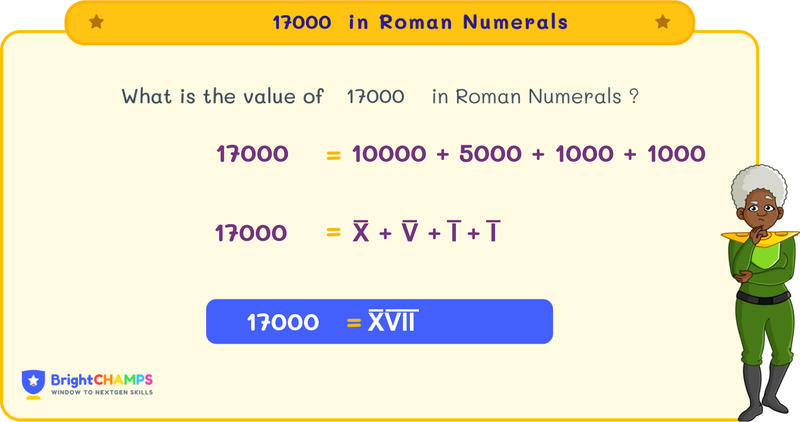Summarize this article:
 367 Learners
367 LearnersLast updated on August 5, 2025
17000 in Roman Numerals

Roman numerals are a system of expressing numbers using symbols. The symbols used are I, V, X, L, C, D, and M. Roman Numerals are frequently used in various contexts such as royal titles, book names, and sequences. Here we will discuss Roman Numerals, rules, and examples.

What is 17000 in Roman Numerals?
Royal titles like Louis XIV and Henry VIII use Roman Numerals. Have you ever wondered what these symbols (XIV and VIII) represent?
They are Roman Numerals. In ancient times, people counted using fingers, sticks, and bones, but as life became more complex, a standardized counting system was needed. The Ancient Romans developed the Roman Numeral system. The symbols used include I (1), V (5), X (10), L (50), C (100), D (500), and M (1000).
To represent 17000 in Roman Numerals, we use XVII with a line over it. The line indicates multiplication by 1000. Let’s explore more about Roman Numerals and how we write them.


Basic Rules for 17000 in Roman Numerals
There are certain basic rules to write numbers in Roman Numerals. In this section, let’s discuss some basic rules that need to be remembered when writing numbers in Roman Numerals.
Rule 1: Addition Method
The addition method is used when a smaller number is placed after a larger number. For example, VI → V + I → 5 + 1 = 6
Rule 2: Repetition Method
Certain Roman Numerals can be repeated up to three times. For example, III → 3.
Rule 3: Subtraction Method
A smaller number followed by a larger number indicates subtraction. For example, IV → V - I → 5 - 1 = 4
Rule 4: Limitation Rule
Symbols cannot be repeated more than three times, and some symbols like V, L, and D cannot be repeated. For example, we won’t write VV for 10; instead, we use X.

How to Write 17000 in Roman Numerals
Let’s learn how to write 17000 in Roman Numerals by following these methods:
- By Expansion Method
- By Grouping Method
Explore Our Programs



17000 in Roman Numeral by Expansion Method
In the expansion method, numbers are broken down based on place value. This section explains how to write 17000 in Roman Numerals using the expansion method.
To write 17000 in Roman Numerals, follow these steps:
Step 1: Break down the number by place value. For 17000, it’s 10000 + 7000.
Step 2: Convert each component into Roman Numerals. 10000 in Roman Numerals — X with a line over it 7000 in Roman Numerals — VII with a line over it
Step 3: Combine the Roman Numerals. Therefore, 17000 in Roman Numerals is X̅ + V̅II̅ = X̅VII̅

17000 in Roman Numeral by Grouping Method
When writing a large number in Roman Numerals, we group the components.
To write 17000 in Roman Numerals, group 17000 as 10000 + 7000.
10000 in Roman Numerals — X with a line over it 7000 in Roman Numerals — VII with a line over it
Therefore, 17000 is written as X̅VII̅ in Roman Numerals.

Common Mistakes and How to Avoid Them in 17000 Roman Numerals
Students often make mistakes when writing numbers in Roman Numerals. To master Roman Numerals, we can learn a few common mistakes and how to avoid them.

17000 in Roman Numerals Examples

Problem 1
A historian finds an ancient document that mentions a fleet of ships numbering XVII times M. How many ships are there in total?

The total number of ships is XVII thousand, or 17000.
Explanation
In Roman numerals, XVII is 17 and M is 1000.
When multiplied together, 17 × 1000 equals 17000.
Therefore, the total number of ships is 17000. In Roman numerals, 17000 can be represented as XVII with a line over it, or simply as XVII thousand.

Problem 2
An architect designs a coliseum with seating for XVII times MD seats. How many seats are there in the coliseum?

The coliseum has a seating capacity of XVII thousand, which is 17000 seats.
Explanation
MD in Roman numerals stands for 1500, and XVII represents 17.
Therefore, when MD is multiplied by XVII, it equals 17 × 1500, resulting in 25500 seats.
However, if we are referring to XVII thousand, it is simply 17000 seats. Thus, the seating capacity is 17000.

Problem 3
A library has a collection of XVII × M books. How many books are in the collection?

The library's collection contains XVII thousand books, which is 17000 books.
Explanation
In Roman numerals, XVII is 17, and M is 1000. Multiplying these gives us 17 × 1000, equaling 17000.
Therefore, the library's collection has 17000 books, which can be denoted as XVII thousand in Roman numerals.

Problem 4
A city plans to plant XVII thousand trees over the next decade. How many trees will be planted each year if they plant an equal number each year?

The city will plant MDCC (1700) trees each year.
Explanation
To find out how many trees are planted each year, divide XVII thousand (17000) by 10 years.
17000 divided by 10 equals 1700. 1700 in Roman numerals is MDCC, so the city will plant MDCC trees each year.

Problem 5
A treasure map indicates a distance of XVII leagues, each league being M steps. How many steps does this cover?

The total distance covered is XVII thousand, or 17000 steps.
Explanation
Each league is M steps, which stands for 1000 steps in Roman numerals.
If the map indicates XVII leagues, that is 17 × 1000 steps, which equals 17000 steps.
Thus, the total distance is 17000 steps, indicated as XVII thousand in Roman numerals.


FAQs on 17000 in Roman Numerals
1.What is 9000 in Roman numerals?
2.How to write 17000 in Roman numerals?
3.What is 16000 in Roman Numerals?
4.Is X̅VII̅ a prime number?
5.What are the multiples of 17000?

Important Glossaries for 17000 in Roman Numerals
- Addition Rule: When a larger numeral is followed by a smaller one, the values are added. For example, XI = X + I = 10 + 1 = 11.
- Grouping Method: Numbers are grouped based on place value, and each group is converted into its Roman numeral. For example, 17000 = 10000 + 7000 = X̅VII̅.
- Repetition Rule: Certain symbols (I, X, C, M) can be repeated up to three times. For example, III = 3.
- Subtraction Rule: When a smaller numeral precedes a larger one, the smaller is subtracted from the larger. For example, IV = V - I = 4.
- Overline Rule: An overline on a numeral indicates multiplication by 1000. For example, X̅ = 10000.



Hiralee Lalitkumar Makwana
About the Author
Hiralee Lalitkumar Makwana has almost two years of teaching experience. She is a number ninja as she loves numbers. Her interest in numbers can be seen in the way she cracks math puzzles and hidden patterns.
Fun Fact
: She loves to read number jokes and games.

















